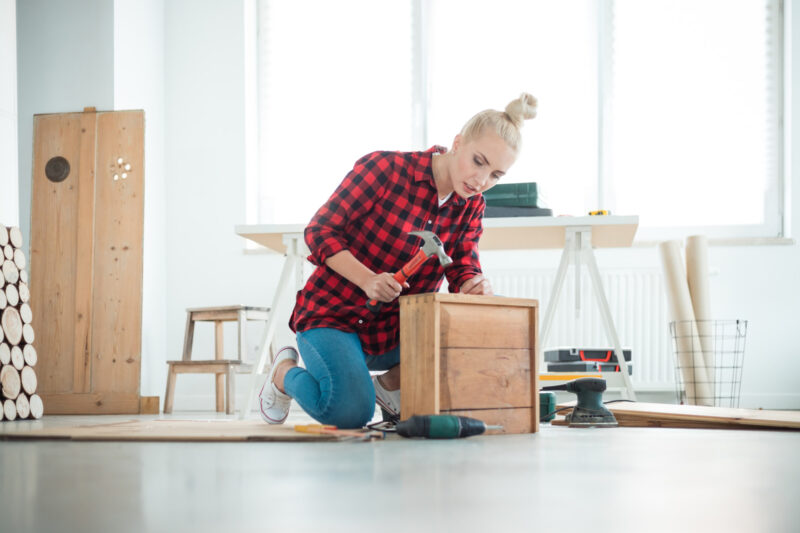Are there a number of projects you’ve been putting off for your home because of budget constraints? Are you considering purchasing a fixer-upper, but don’t know if you’re up to the task of doing the actual fixing?
When it comes to DIY home repairs, they can seem daunting if you don’t have the experience or the right tools to do the job. According to a 2018 home report, 31% of homeowners admitted they don’t have money set aside for any repairs or improvements.
If you’re in this boat, creating a budget and learning more about DIY repairs can set you up for serious savings. Read on to learn all about a new DIY home improvement project you can do on your own today!
1. Fixing Broken Toilet Levers
Fixing a broken toilet lever is one of the most useful projects to know, as this is a simple project that takes care of a common issue. You’ll know your lever is acting up when pushing it doesn’t flush the toilet like normal. Hopefully, all you’ll have to do is open up the toilet tank and reattach the chain for the lever.
You can still fix it yourself if the chain is corroded or any other parts are broken. Just make sure that you’re equipped with an adjustable wrench as well as a replacement toilet lever kit if you find that there are broken parts. These kits can be bought online or at any local hardware store for five to ten dollars.
We recommend taking a photo of the old lever to see how it’s assembled. All you’ll need to do is loosen up the plastic nut in the toilet tank behind the lever. Then use your replacement toilet kit to install the new lever.
2. Fixing Loud Cabinet Doors
Do your cabinet doors often slam shut and you have to put effort into closing them slowly? DIY fixes don’t have to be costly or time-consuming, and this is another great example. All you have to do is purchase peel-and-stick door and drawer bumpers either online or at a local hardware store.
You’ll first want to clean off the back of the door with a soft rag and some denatured alcohol. Once the area is dry, all you have to do is stick the bumpers to the top and bottom corners of the loud cabinets.
3. Garage Door Repairs
Since garage doors are heavy and come with multiple moving parts, it’s important that you take some time to decide whether a professional is necessary. If a garage door is malfunctioning in any way, this is a good time to get a professional involved.
However, if your garage door is working fine but is clattering or making strange noises, you may be able to find an affordable DIY solution. For instance, you can try tightening all the hardware inside and outside.
Garage door lubrication offered by stanley garage is also a simple way to try and reduce loud noises.
4. Using Spray Foam
Spray foam is a product that we recommend for all new and old homeowners, as it has a surprising number of uses for frequent home issues. This type of insulation is great at getting into crevices and hardening into a sturdy material. Once it’s hardened, it can also be carved in order to create a better appearance.
If there are gaps or cracks in your walls that are letting in pests and moisture, you can fill in those gaps with copper mesh and then a small amount of expanding foam. You can also spray the foam around gaps that create wobbly shower arms. Once the spray is set, it can be easily carved away.
Lastly, you can also use foam in order to dull noise, such as from sinks or water supply lines. This is caused by the vibration of the pipes being amplified by the wooden wall and floor framing around them. If there’s no way to reach the pipes, drill a small hole and spray a moderate amount of expanding foam inside.
5. Patching Drywall
There will come a time when you need to rearrange art or fix holes that past homeowners have made. Luckily, patching up drywall is a straightforward process that all homeowners can learn.
For small holes or dents created by nails, fill the hole with lightweight spackle. You can do this with your finger or a putty knife. You’ll want to make sure that the spackle is level with the rest of the wall.
Once the spackle is dry after about 30 minutes, you can paint over it for a seamless appearance. There are a variety of methods to match paint, such as comparing paint chips or using an app.
Your First DIY Home Improvement Project
When it comes to tackling your first DIY home improvement project, start small. Tackle a project that’s been on the back of your mind for a while and that you believe you can take care of today. Once you have experience with this project, you’ll find you have the confidence to handle larger projects in the future.
For instance, fixing loud cabinet doors or even broken toilet levers are both simple DIY home improvements that only require the purchase of one more item. Once you purchase cabinet bumpers or a toilet lever kit, it’s as simple as assembling these items.
Ready for more tips on how to take care of your home while keeping your finances and budget in check? Keep reading the blog for more important tips and strategies!





Leave a Reply
You must be logged in to post a comment.